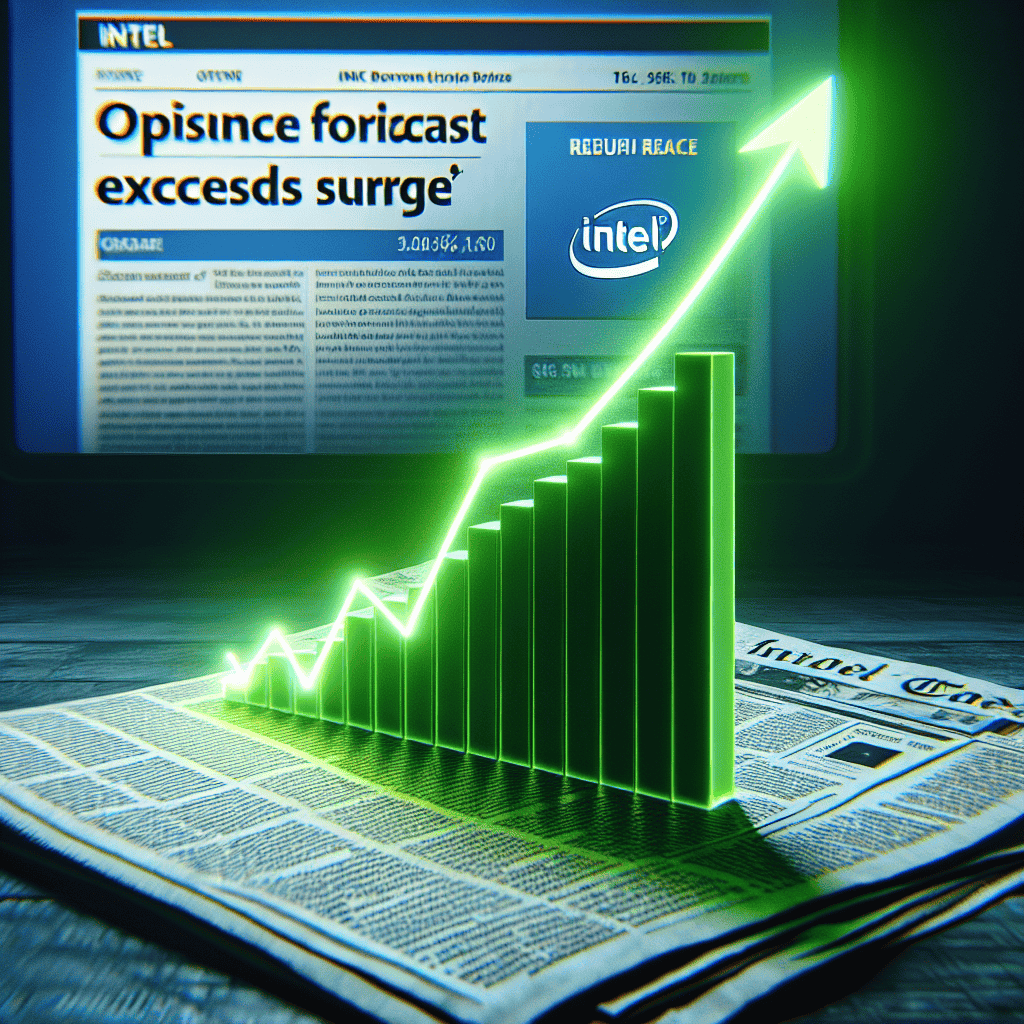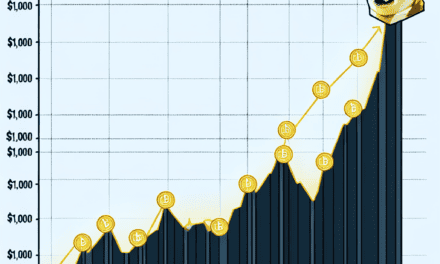“Intel Ignites: Surging Shares on Sky-High Revenue Forecasts!”
Introduction
Intel’s shares experienced a significant surge following the company’s release of an optimistic revenue forecast that surpassed market expectations. This positive outlook has invigorated investor confidence, reflecting a potential turnaround for the tech giant amid a competitive semiconductor industry landscape. The forecast suggests robust demand for Intel’s products and strategic advancements in its business operations, signaling a promising trajectory for future growth. This development comes as a welcome boost for Intel, which has been navigating challenges in maintaining its market position against rivals. The market’s reaction underscores the importance of Intel’s strategic initiatives and its ability to adapt to evolving industry dynamics.
Intel’s Revenue Forecast: A Closer Look at the Factors Behind the Surge
Intel’s recent announcement of an optimistic revenue forecast has sent its shares surging, capturing the attention of investors and industry analysts alike. This unexpected upward revision in revenue projections has sparked a wave of enthusiasm, as it suggests a potential turnaround for the tech giant, which has faced significant challenges in recent years. To understand the factors driving this surge, it is essential to delve into the strategic decisions and market dynamics that have contributed to Intel’s newfound optimism.
One of the primary factors behind Intel’s improved revenue forecast is its strategic focus on expanding its product offerings and diversifying its business model. In recent years, Intel has made significant investments in research and development, aiming to enhance its competitive edge in the semiconductor industry. By prioritizing innovation, the company has been able to introduce new products that cater to the evolving needs of its customers. This includes advancements in artificial intelligence, data centers, and Internet of Things (IoT) technologies, which have opened up new revenue streams and positioned Intel as a key player in these rapidly growing markets.
Moreover, Intel’s commitment to strengthening its manufacturing capabilities has played a crucial role in its optimistic outlook. The company has been investing heavily in upgrading its fabrication facilities, with a focus on increasing production capacity and improving process technology. This strategic move not only addresses the global semiconductor shortage but also enhances Intel’s ability to meet the rising demand for its products. As a result, the company is better positioned to capture market share and drive revenue growth in the coming quarters.
In addition to its internal strategies, Intel’s revenue forecast has been bolstered by favorable market conditions. The global demand for semiconductors continues to rise, driven by the proliferation of digital technologies and the increasing reliance on electronic devices. This trend has been further accelerated by the ongoing digital transformation across various industries, as businesses seek to leverage technology to enhance efficiency and drive innovation. Consequently, Intel stands to benefit from this sustained demand, as its products are integral to powering the digital infrastructure that underpins modern economies.
Furthermore, Intel’s strategic partnerships and collaborations have contributed to its positive revenue outlook. By forging alliances with key players in the technology ecosystem, Intel has been able to expand its reach and tap into new markets. These partnerships have facilitated the development of innovative solutions that address specific industry needs, thereby enhancing Intel’s value proposition to its customers. As a result, the company has been able to secure long-term contracts and strengthen its position in the competitive semiconductor landscape.
While Intel’s optimistic revenue forecast is undoubtedly encouraging, it is important to acknowledge the challenges that lie ahead. The semiconductor industry is characterized by rapid technological advancements and intense competition, which necessitate continuous innovation and adaptation. Intel must remain vigilant in its efforts to stay ahead of the curve and maintain its market leadership. Additionally, geopolitical tensions and supply chain disruptions pose potential risks that could impact the company’s operations and financial performance.
In conclusion, Intel’s surge in shares following its optimistic revenue forecast is a testament to the company’s strategic initiatives and favorable market conditions. By focusing on innovation, manufacturing excellence, and strategic partnerships, Intel has positioned itself for growth in the dynamic semiconductor industry. However, the company must navigate potential challenges to sustain its momentum and capitalize on emerging opportunities. As Intel continues to execute its strategic vision, stakeholders will be keenly observing its progress and the impact on its financial performance in the coming quarters.
Market Reactions: How Intel’s Optimistic Forecast Impacted Share Prices
Intel Corporation, a leading player in the semiconductor industry, recently witnessed a significant surge in its share prices following the release of an optimistic revenue forecast that exceeded market expectations. This development has captured the attention of investors and analysts alike, as it signals a potential turnaround for the company amidst a challenging economic landscape. The positive forecast, which was unveiled during Intel’s latest earnings call, has not only bolstered investor confidence but also sparked a broader discussion about the company’s strategic direction and its implications for the semiconductor market.
The announcement of the revenue forecast came as a pleasant surprise to many, given the recent headwinds faced by the semiconductor industry. Supply chain disruptions, geopolitical tensions, and fluctuating demand have all contributed to a volatile market environment. However, Intel’s management expressed confidence in their ability to navigate these challenges, citing advancements in their product offerings and strategic investments in key growth areas. This optimistic outlook was further supported by the company’s commitment to expanding its manufacturing capabilities and enhancing its technological prowess.
In response to the forecast, Intel’s shares experienced a notable uptick, reflecting the market’s positive reception of the company’s future prospects. Investors were particularly encouraged by Intel’s plans to capitalize on emerging trends such as artificial intelligence, cloud computing, and the Internet of Things. These areas are expected to drive significant demand for semiconductors in the coming years, and Intel’s proactive approach to positioning itself as a leader in these domains has resonated well with stakeholders.
Moreover, the market’s reaction to Intel’s forecast underscores the importance of strategic foresight and adaptability in the technology sector. As companies grapple with rapid technological advancements and shifting consumer preferences, those that can anticipate and respond to these changes are more likely to thrive. Intel’s ability to articulate a clear vision for its future growth has not only reassured investors but also set a benchmark for its competitors.
Transitioning to the broader implications of Intel’s forecast, it is essential to consider how this development might influence the semiconductor industry as a whole. Intel’s optimistic outlook could potentially spur increased investment and innovation across the sector, as other companies seek to emulate its success. This, in turn, could lead to a more dynamic and competitive market environment, ultimately benefiting consumers through improved products and services.
Furthermore, Intel’s forecast may also have a ripple effect on related industries, such as consumer electronics and automotive, which rely heavily on semiconductor technology. As Intel and its peers continue to push the boundaries of innovation, these industries stand to gain from enhanced capabilities and efficiencies, driving further economic growth and development.
In conclusion, Intel’s optimistic revenue forecast has had a profound impact on its share prices, reflecting the market’s confidence in the company’s strategic direction and growth potential. This development highlights the critical role of foresight and adaptability in the technology sector, as well as the broader implications for the semiconductor industry and related markets. As Intel continues to execute its vision, it will be closely watched by investors, competitors, and industry stakeholders, all eager to see how the company navigates the challenges and opportunities that lie ahead.
Intel’s Strategic Moves: Key Decisions Leading to Revenue Growth
Intel’s recent surge in share prices can be attributed to a series of strategic decisions that have positioned the company for significant revenue growth, surpassing market expectations. This optimistic revenue forecast is not merely a stroke of luck but rather the result of deliberate and calculated moves by Intel’s leadership. As the semiconductor industry continues to evolve rapidly, Intel has demonstrated a keen ability to adapt and innovate, ensuring its relevance and competitiveness in a challenging market landscape.
One of the pivotal decisions contributing to Intel’s promising outlook is its substantial investment in research and development. By allocating significant resources to R&D, Intel has been able to push the boundaries of semiconductor technology, leading to the development of more advanced and efficient processors. This focus on innovation has allowed Intel to maintain its edge over competitors, particularly in the realm of high-performance computing and data centers, where demand for cutting-edge technology is ever-increasing.
In addition to its commitment to innovation, Intel has also made strategic acquisitions that have bolstered its capabilities and expanded its market reach. By acquiring companies with complementary technologies and expertise, Intel has been able to integrate new solutions into its product offerings, thereby enhancing its value proposition to customers. These acquisitions have not only diversified Intel’s portfolio but have also opened up new revenue streams, contributing to the company’s overall growth.
Moreover, Intel’s strategic partnerships have played a crucial role in its recent success. By collaborating with other industry leaders, Intel has been able to leverage synergies and co-develop solutions that address the evolving needs of the market. These partnerships have facilitated the sharing of knowledge and resources, enabling Intel to accelerate its innovation cycle and bring new products to market more swiftly. As a result, Intel has been able to capture a larger share of the market, further driving its revenue growth.
Furthermore, Intel’s focus on sustainability and corporate responsibility has resonated well with investors and customers alike. By prioritizing environmentally friendly practices and setting ambitious sustainability goals, Intel has positioned itself as a responsible corporate citizen. This commitment to sustainability not only enhances Intel’s brand image but also aligns with the growing demand for eco-friendly products and practices, thereby attracting a broader customer base.
In light of these strategic moves, Intel’s optimistic revenue forecast is a testament to the effectiveness of its leadership and vision. The company’s ability to anticipate market trends and respond proactively has been instrumental in its recent success. As Intel continues to execute its strategic initiatives, it is well-positioned to capitalize on emerging opportunities and navigate potential challenges in the semiconductor industry.
In conclusion, Intel’s surge in share prices is a reflection of the company’s strategic foresight and execution. Through its investments in innovation, strategic acquisitions, partnerships, and commitment to sustainability, Intel has laid a solid foundation for continued revenue growth. As the company moves forward, it remains poised to maintain its leadership position in the semiconductor industry, delivering value to shareholders and customers alike. The optimistic revenue forecast is not just a short-term gain but a promising indicator of Intel’s long-term potential and resilience in an ever-evolving market.
Investor Confidence: Analyzing the Boost in Intel’s Market Value

Intel’s recent surge in market value has captured the attention of investors and analysts alike, as the company’s optimistic revenue forecast exceeded expectations, signaling a potential turnaround for the tech giant. This development comes at a crucial time for Intel, which has faced significant challenges in recent years, including increased competition and supply chain disruptions. The company’s latest forecast, however, suggests a renewed sense of confidence in its ability to navigate these obstacles and capitalize on emerging opportunities in the semiconductor industry.
The positive revenue forecast can be attributed to several key factors that have bolstered investor confidence. Firstly, Intel’s strategic investments in advanced manufacturing technologies have begun to bear fruit, enabling the company to produce more efficient and powerful chips. This technological edge is crucial in maintaining competitiveness against rivals such as AMD and NVIDIA, who have been gaining market share with their innovative offerings. By focusing on cutting-edge manufacturing processes, Intel aims to reclaim its position as a leader in the semiconductor space.
Moreover, Intel’s expansion into new markets has also contributed to its optimistic outlook. The company has been actively pursuing opportunities in areas such as artificial intelligence, autonomous vehicles, and 5G technology. These sectors are expected to experience significant growth in the coming years, and Intel’s early investments position it well to capture a substantial share of these burgeoning markets. As a result, investors are increasingly confident in Intel’s ability to diversify its revenue streams and reduce its reliance on traditional PC and server markets.
In addition to its strategic initiatives, Intel’s strong financial performance has further reinforced investor confidence. The company has consistently delivered robust earnings, driven by solid demand for its products and effective cost management. This financial stability provides a solid foundation for Intel to continue investing in research and development, ensuring that it remains at the forefront of technological innovation. Furthermore, Intel’s commitment to returning value to shareholders through dividends and share buybacks has also played a role in boosting its market value.
However, it is important to acknowledge the challenges that Intel still faces. The semiconductor industry is highly competitive, and maintaining a technological edge requires continuous innovation and substantial investment. Additionally, global supply chain disruptions and geopolitical tensions pose ongoing risks that could impact Intel’s operations and profitability. Nevertheless, the company’s proactive approach to addressing these challenges, coupled with its strong financial position, suggests that it is well-equipped to navigate the complexities of the industry.
In conclusion, Intel’s recent surge in market value reflects a renewed sense of investor confidence, driven by an optimistic revenue forecast that exceeded expectations. The company’s strategic investments in advanced manufacturing technologies and expansion into new markets have positioned it well for future growth. While challenges remain, Intel’s strong financial performance and commitment to innovation provide a solid foundation for continued success. As the semiconductor industry continues to evolve, Intel’s ability to adapt and capitalize on emerging opportunities will be crucial in maintaining its competitive edge and delivering value to shareholders. This optimistic outlook has undoubtedly contributed to the recent boost in Intel’s market value, signaling a promising future for the tech giant.
Competitive Edge: Intel’s Position in the Semiconductor Industry
Intel’s recent surge in share prices, driven by an optimistic revenue forecast that exceeded market expectations, underscores the company’s strategic positioning within the highly competitive semiconductor industry. This development not only highlights Intel’s resilience but also its ability to adapt and innovate in a rapidly evolving technological landscape. As the semiconductor industry continues to experience unprecedented demand, fueled by advancements in artificial intelligence, cloud computing, and the Internet of Things, Intel’s proactive approach to addressing these trends has positioned it favorably among its competitors.
One of the key factors contributing to Intel’s optimistic revenue forecast is its significant investment in research and development. By prioritizing innovation, Intel has been able to enhance its product offerings, ensuring they meet the ever-increasing demands for performance and efficiency. This commitment to innovation is evident in Intel’s recent advancements in chip architecture, which have not only improved processing power but also energy efficiency, a critical consideration in today’s environmentally conscious market. Furthermore, Intel’s strategic partnerships and collaborations with other technology leaders have enabled it to leverage complementary strengths, thereby expanding its market reach and enhancing its competitive edge.
In addition to its focus on innovation, Intel’s robust supply chain management has played a crucial role in its recent success. The semiconductor industry has been plagued by supply chain disruptions, exacerbated by geopolitical tensions and the global pandemic. However, Intel’s proactive measures to secure critical components and diversify its supplier base have mitigated these challenges, ensuring a steady production flow. This strategic foresight has not only allowed Intel to meet current demand but also to position itself to capitalize on future growth opportunities as the industry continues to expand.
Moreover, Intel’s strategic expansion into new markets has further bolstered its competitive position. Recognizing the growing importance of data-centric technologies, Intel has made significant strides in areas such as data centers and edge computing. By aligning its product development with these emerging trends, Intel has been able to capture a larger share of the market, thereby driving revenue growth. This strategic diversification not only reduces Intel’s reliance on traditional PC markets but also positions it to benefit from the increasing demand for data processing and storage solutions.
While Intel’s recent performance is commendable, it is important to acknowledge the challenges that lie ahead. The semiconductor industry is characterized by rapid technological advancements and intense competition, with major players such as AMD and NVIDIA continually pushing the boundaries of innovation. To maintain its competitive edge, Intel must continue to invest in cutting-edge technologies and adapt to changing market dynamics. Additionally, addressing environmental concerns and ensuring sustainable practices will be crucial as consumers and regulators increasingly prioritize sustainability.
In conclusion, Intel’s recent surge in share prices, driven by an optimistic revenue forecast, reflects its strategic positioning within the semiconductor industry. Through a combination of innovation, robust supply chain management, and strategic market expansion, Intel has demonstrated its ability to navigate the challenges of a dynamic industry landscape. As the demand for semiconductors continues to grow, Intel’s proactive approach and commitment to excellence position it well to capitalize on future opportunities and maintain its competitive edge.
Future Outlook: What Intel’s Revenue Forecast Means for the Tech Sector
Intel’s recent announcement of an optimistic revenue forecast has sent ripples through the tech sector, as the company’s shares surged in response to the unexpected news. This development not only highlights Intel’s strategic positioning within the industry but also offers a glimpse into the broader implications for the tech sector as a whole. As investors and analysts digest the implications of Intel’s forecast, it becomes evident that the company’s outlook could serve as a bellwether for future trends in technology and innovation.
To begin with, Intel’s revised revenue forecast suggests a renewed confidence in its ability to navigate the challenges that have beset the semiconductor industry in recent years. The global chip shortage, exacerbated by supply chain disruptions and increased demand, has posed significant hurdles for manufacturers. However, Intel’s optimistic projection indicates that the company is effectively managing these challenges, potentially through strategic investments in manufacturing capabilities and supply chain resilience. This, in turn, could signal a stabilization of the semiconductor market, providing a foundation for growth across the tech sector.
Moreover, Intel’s forecast underscores the importance of innovation and technological advancement in driving revenue growth. As the company continues to invest in research and development, it positions itself to capitalize on emerging trends such as artificial intelligence, 5G connectivity, and the Internet of Things. These technologies are expected to drive demand for more advanced and efficient semiconductor solutions, and Intel’s commitment to innovation suggests that it is well-positioned to meet this demand. Consequently, other companies within the tech sector may be encouraged to increase their own investments in R&D, fostering a competitive environment that could accelerate technological progress.
In addition to its implications for innovation, Intel’s revenue forecast also highlights the potential for increased collaboration and partnerships within the tech industry. As companies seek to leverage each other’s strengths to address complex challenges, Intel’s optimistic outlook may encourage more strategic alliances. Such collaborations could lead to the development of new products and services, further driving growth and diversification within the sector. This trend towards increased cooperation could also facilitate the sharing of resources and expertise, ultimately benefiting the industry as a whole.
Furthermore, Intel’s forecast may have a positive impact on investor sentiment, not only for the company itself but also for the tech sector at large. As investors gain confidence in Intel’s ability to deliver on its projections, they may be more inclined to invest in other tech companies, particularly those with strong growth potential. This influx of capital could provide the necessary resources for companies to expand their operations, invest in new technologies, and explore new markets. In turn, this could lead to a virtuous cycle of growth and innovation, further solidifying the tech sector’s role as a key driver of economic progress.
In conclusion, Intel’s optimistic revenue forecast serves as a significant indicator of the company’s strategic direction and its potential impact on the broader tech sector. By effectively managing industry challenges, investing in innovation, fostering collaboration, and boosting investor confidence, Intel is poised to play a pivotal role in shaping the future of technology. As the tech sector continues to evolve, Intel’s outlook offers valuable insights into the opportunities and challenges that lie ahead, providing a roadmap for companies seeking to thrive in an increasingly competitive and dynamic landscape.
Financial Analysis: Understanding the Implications of Intel’s Revenue Surge
Intel’s recent announcement of an optimistic revenue forecast has sent its shares surging, capturing the attention of investors and analysts alike. This unexpected upward revision in revenue projections has sparked a wave of enthusiasm in the financial markets, prompting a closer examination of the factors contributing to this positive outlook. As we delve into the implications of Intel’s revenue surge, it is essential to consider the broader context of the semiconductor industry and the strategic maneuvers that have positioned Intel for this promising trajectory.
To begin with, Intel’s revised revenue forecast is a testament to its resilience and adaptability in an industry characterized by rapid technological advancements and intense competition. The semiconductor giant has faced significant challenges in recent years, including supply chain disruptions and competitive pressures from rivals such as AMD and NVIDIA. However, Intel’s ability to navigate these obstacles and emerge with a stronger-than-expected revenue outlook underscores its strategic acumen and operational efficiency. This development is particularly noteworthy given the backdrop of a global semiconductor shortage, which has affected numerous industries reliant on chip technology.
Moreover, Intel’s optimistic revenue forecast can be attributed to its strategic investments in research and development, as well as its commitment to innovation. The company’s focus on expanding its product portfolio and enhancing its manufacturing capabilities has played a crucial role in driving growth. For instance, Intel’s advancements in processor technology and its foray into new markets, such as artificial intelligence and autonomous vehicles, have opened up new revenue streams. These initiatives not only bolster Intel’s competitive position but also align with the growing demand for cutting-edge technology solutions across various sectors.
In addition to its internal strategies, Intel’s revenue surge is also influenced by external market dynamics. The increasing digitalization of industries and the proliferation of connected devices have fueled demand for semiconductors, creating a favorable environment for companies like Intel. As businesses and consumers continue to embrace digital transformation, the need for high-performance computing solutions is expected to rise, further supporting Intel’s growth prospects. This trend is particularly evident in sectors such as cloud computing, data centers, and the Internet of Things, where Intel’s products are integral to enabling seamless connectivity and processing capabilities.
Furthermore, Intel’s optimistic revenue forecast has significant implications for its financial performance and shareholder value. The surge in share prices reflects investor confidence in the company’s ability to capitalize on emerging opportunities and deliver sustainable growth. This positive sentiment is likely to enhance Intel’s market capitalization and strengthen its position as a leading player in the semiconductor industry. Additionally, the improved revenue outlook may provide Intel with greater financial flexibility to pursue strategic acquisitions, invest in cutting-edge technologies, and return value to shareholders through dividends and share buybacks.
In conclusion, Intel’s optimistic revenue forecast exceeding expectations is a pivotal moment for the company and the semiconductor industry as a whole. By leveraging its strategic initiatives, capitalizing on market trends, and demonstrating resilience in the face of challenges, Intel has positioned itself for a promising future. As the company continues to innovate and expand its footprint in emerging markets, its revenue surge serves as a testament to its enduring relevance and potential for long-term success. Investors and industry observers will undoubtedly keep a close watch on Intel’s progress, eager to see how the company navigates the evolving landscape and seizes new opportunities in the ever-changing world of technology.
Q&A
1. **What caused Intel shares to surge?**
Intel shares surged due to an optimistic revenue forecast that exceeded market expectations.
2. **What was the market’s reaction to Intel’s revenue forecast?**
The market reacted positively, leading to a significant increase in Intel’s share price.
3. **How did Intel’s revenue forecast compare to analysts’ expectations?**
Intel’s revenue forecast was higher than what analysts had anticipated.
4. **What impact did the revenue forecast have on investor sentiment?**
The optimistic revenue forecast improved investor sentiment towards Intel.
5. **Did Intel provide any specific figures in their revenue forecast?**
Yes, Intel provided specific figures, but the exact numbers would depend on the context of the report.
6. **What sector does Intel operate in?**
Intel operates in the semiconductor and technology sector.
7. **How might this revenue forecast affect Intel’s future business strategies?**
A positive revenue forecast might encourage Intel to invest more in research and development, expand production capabilities, or explore new markets.
Conclusion
Intel’s shares experienced a significant surge following the company’s announcement of an optimistic revenue forecast that exceeded market expectations. This positive outlook reflects investor confidence in Intel’s strategic initiatives and potential growth, likely driven by advancements in technology, product innovation, and effective market positioning. The upward movement in share prices underscores the market’s favorable reception to Intel’s future prospects and its ability to navigate competitive industry challenges.





